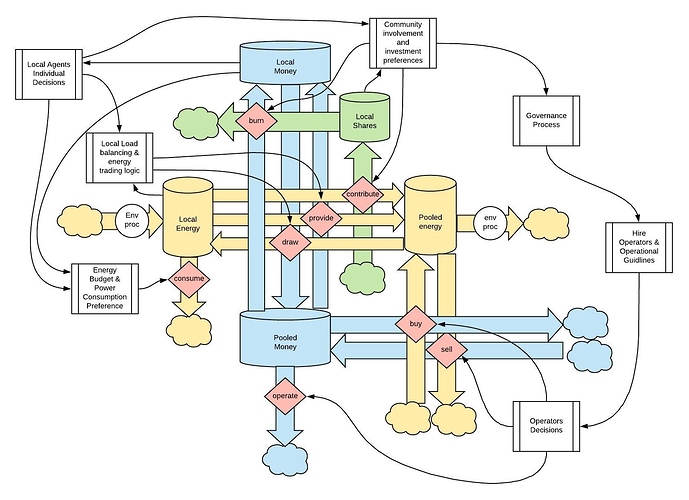Summary
Consider the case of a local power grid comprised of Prosumers. Prosumers have Solartainers which capture and store solar energy for use by the household that captured it, and which can be sold into the local grid. This architecture is very appealing especially in emerging markets where access to traditional grid infrastructure is inconsistent or unavailable. In practice there are still challenges because this produces a highly illiquid local energy market and doesn’t not immediately lend itself to coordinated behavior on the part of the community. If this infrastructure is not community owned, the institution coordinating the exchange of power is in a position to extract value from the local grid and does not provide the desired community level incentives. This can be addressed through the use of Token Engineering practices including multi-scale models of agents and system, along with the application of the liquidity pool design pattern. This reference case is being developed in collaboration with Sebnem (@solsista) at freeel.io. We will use this thread to flesh out this example further to allow community member to join in hacking on this important use case!
Note that this system would be a special case extended version of the Uniswap model where tokenized energy was used in place of ETH. Check out @markusbkoch modeling of uniswap and analysis of liquidity providers here:
We imagine extending this model with specialize dynamics that account for the properties of the local grid. While the use case is different, the core components of the liquidity pool model remain intact.
Can you please confirm a few things for me on the stock and flow diagram syntax?
- Diamonds are taps
- Cylinders are stocks
- Arrows are flows
- Rectangles are computations/decisions that are used in other decisions and taps?
And some questions :
- What does it mean when there is a tap at the intersection of 2 flows?
- What does the circle between the clouds and stocks mean?
- How does a stock and flow diagram map to a differential specification?
I definitely need to write detailed guide to those stock and flow diagrams; I just haven’t had the time yet. It is on my todo. In the mean time, the most important answer is flows crossing on a tap encodes a sort of entanglement between the flows.
The reason I use Diamonds not faucets like in Sterman’s book is to highlight that these are active choices of agents (or groups of agents) not merely passive flows.
An action on a diamond that links two arrows is an action that defines both flows in a deterministic way
The best example is the augmented bonding curve as laid out in Abbey’s article
I’ll tag you when i get a chance to write this up as more of a tutorial.
This is a video, of a project intiation in Niger - which is researched by journalists from ZDF (German public television), gives good overview on the complexities and stakeholders in the villages: https://www.youtube.com/watch?v=4vBjvwyBnl0&feature=youtu.be
This thread definitely needs a link to @colin’s awesome article mapping out a Solartainer System and Stakeholder model:
I hope we can also get a link to his cadCAD code too!

